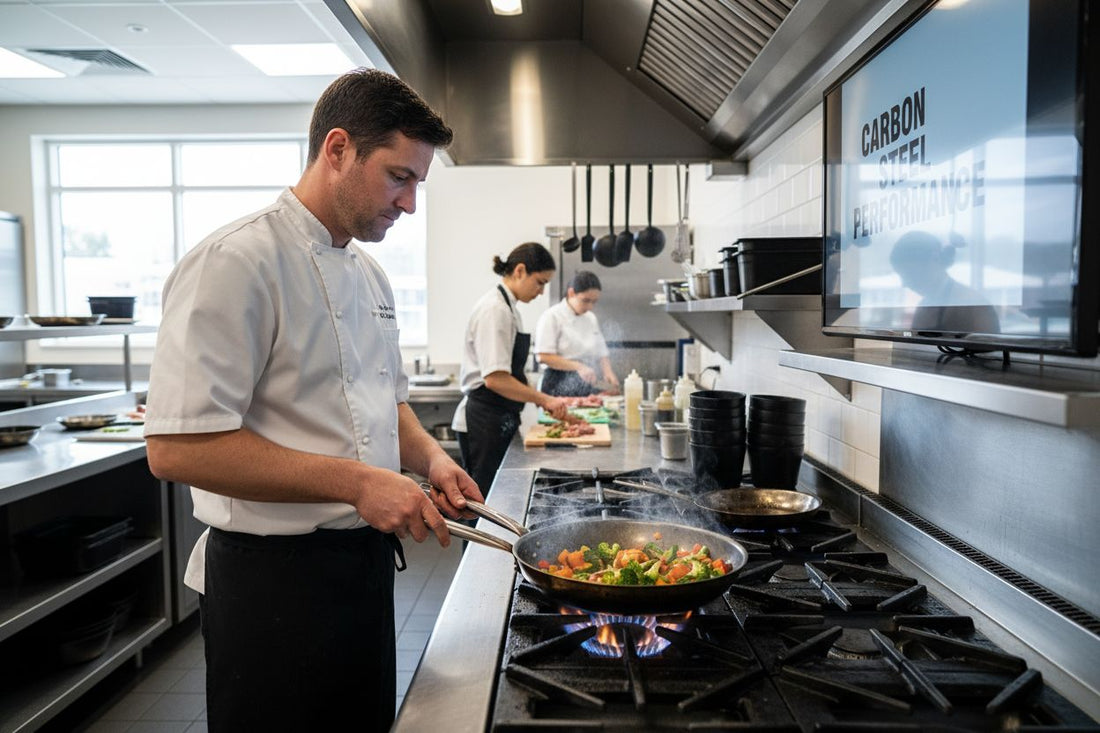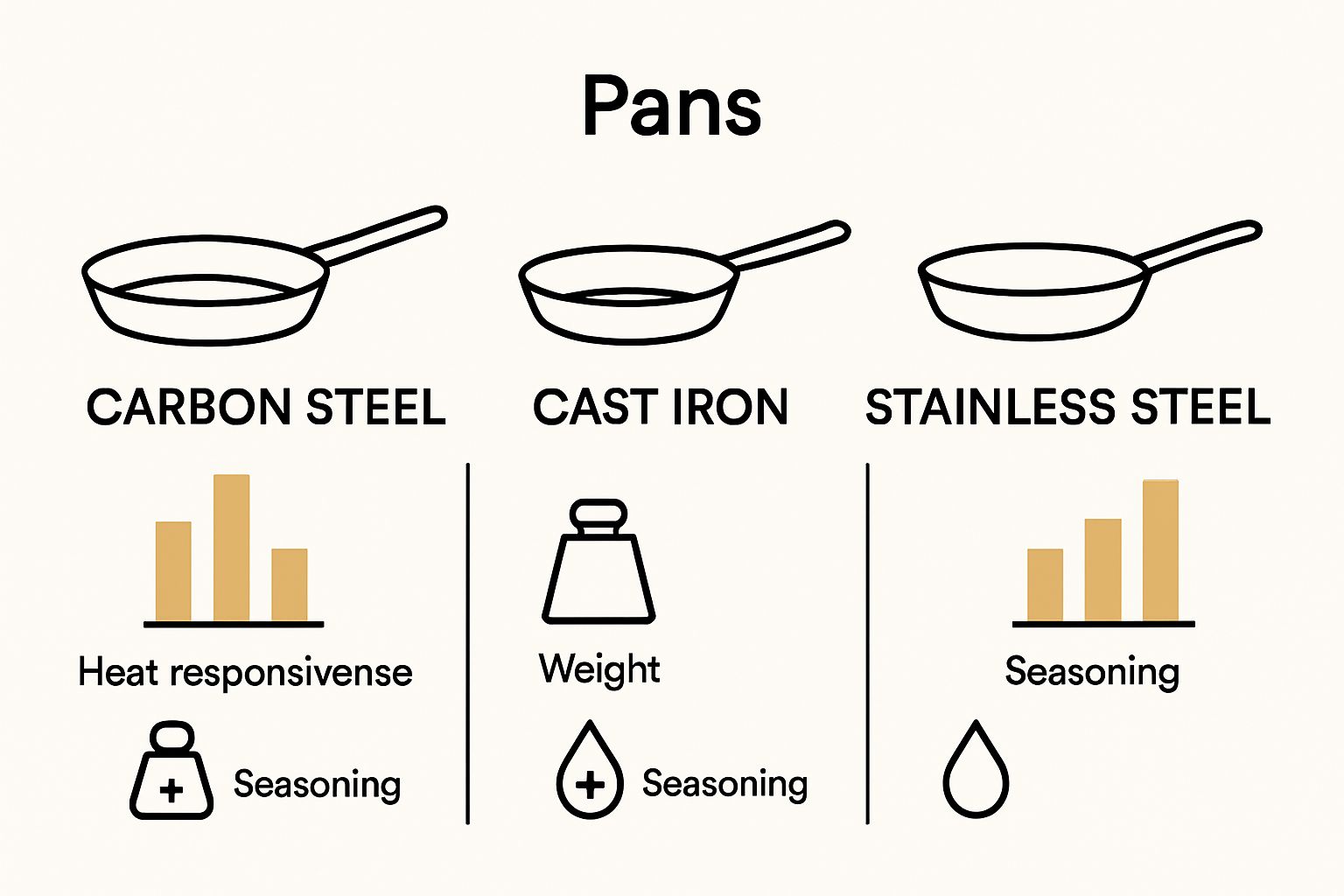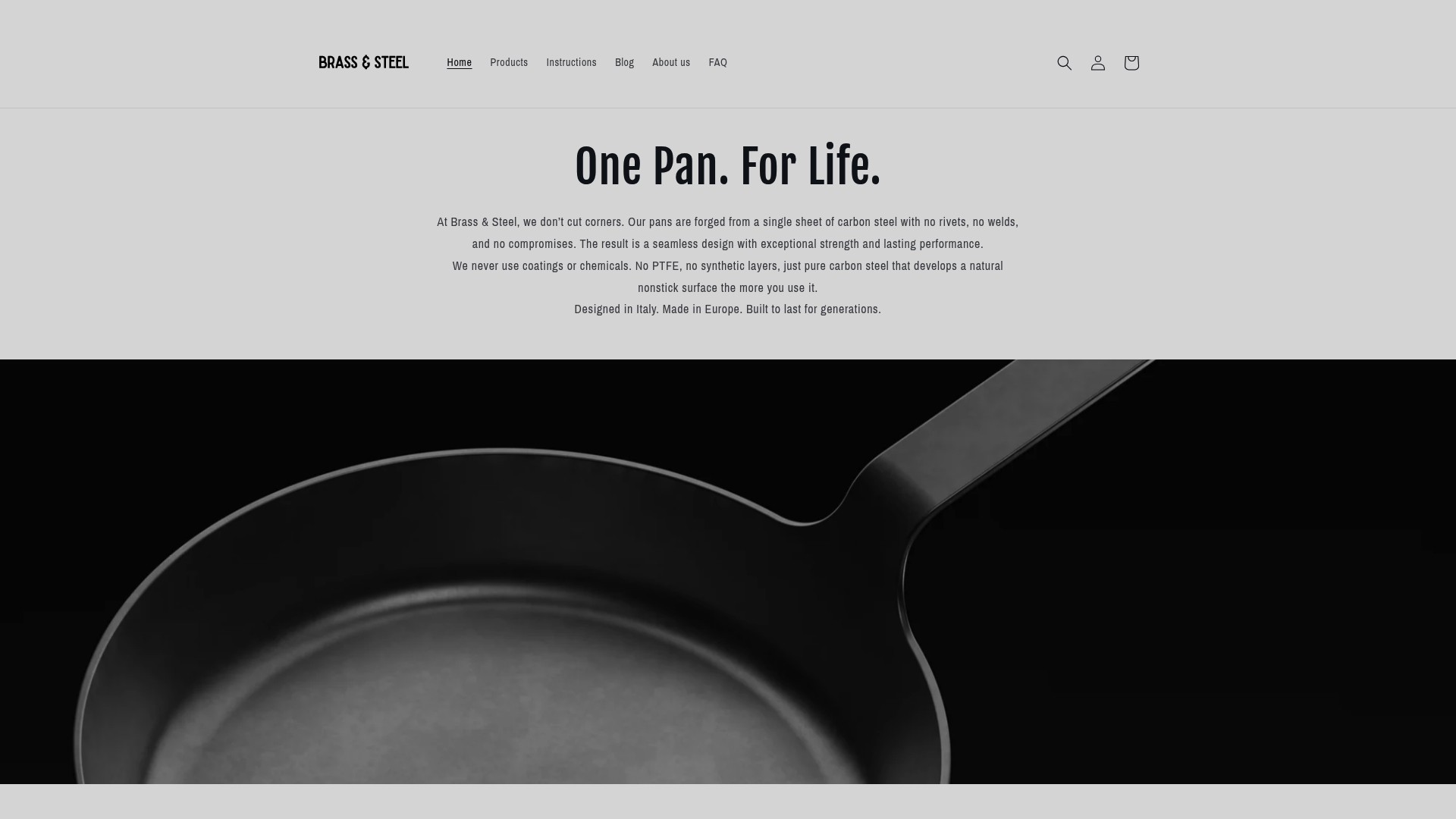
Understanding What is Carbon Steel Cookware Performance
Share
Carbon steel cookware is everywhere in professional kitchens and for good reason. With a composition that includes up to 2.1 percent carbon by weight, it delivers both heat responsiveness and durability in a way that surprises even seasoned chefs. Yet the most unexpected part is how its performance actually improves over time—the more you use it, the better and more non-stick it becomes.
Table of Contents
- Defining Carbon Steel Cookware And Its Composition
- The Unique Properties Of Carbon Steel Cookware
- Performance Factors: Heat Retention And Cooking Versatility
- Seasoning And Maintenance: Key To Longevity And Performance
- Real-World Applications: Chefs And Restaurants Using Carbon Steel
Quick Summary
| Takeaway | Explanation |
|---|---|
| Carbon steel cookware offers superior heat responsiveness. | Its unique composition allows for rapid and uniform heat distribution, essential for precise cooking control. |
| Proper seasoning enhances non-stick properties. | Layering oils through seasoning creates a naturally non-stick surface, improving performance over time. |
| Lightweight compared to cast iron, yet durable. | Carbon steel provides strength without the heft, making it ideal for frequent use. |
| Versatile for various cooking methods. | Suitable for stovetop, oven, and direct flame cooking, accommodating a wide range of techniques. |
| Regular maintenance is crucial for longevity. | Simple practices like drying and oiling after use can significantly extend the lifespan of carbon steel cookware. |
Defining Carbon Steel Cookware and Its Composition
Carbon steel cookware represents a remarkable intersection of metallurgy and culinary engineering, offering professional chefs and passionate home cooks a versatile cooking surface with exceptional performance characteristics. Learn more about carbon steel pan fundamentals to understand its unique properties.
Material Composition and Metallurgical Foundations
Carbon steel is an alloy primarily composed of iron and carbon, typically containing between 0.05% and 2.1% carbon by weight. This specific composition distinguishes it from other metal cookware materials like stainless steel or cast iron. The carbon content determines several critical performance attributes:
- Thermal Conductivity: Higher carbon percentages enable faster and more uniform heat distribution
- Structural Strength: Carbon enhances the metal’s overall durability and resistance to deformation
- Surface Reactivity: Allows for natural seasoning and development of a protective cooking patina
Performance Characteristics of Carbon Steel
The metallurgical structure of carbon steel creates unique cooking dynamics. Unlike non-stick surfaces that rely on chemical coatings, carbon steel develops a natural non-stick surface through seasoning. When heated and treated with cooking oils, the pan develops a polymerised layer that prevents food from sticking and provides excellent heat retention.
Professional kitchens favour carbon steel for its remarkable heat responsiveness. The material heats quickly and distributes temperature evenly, allowing chefs to achieve precise searing, efficient browning, and consistent cooking results. Scientific research from Materials Science journals confirms that the molecular structure of carbon steel enables rapid thermal transfer with minimal heat loss.
Key performance advantages include:
- Lightweight compared to cast iron
- Faster heat response than traditional cookware
- Capable of withstanding extremely high temperatures
- Develops improved non-stick properties with continued use
By understanding carbon steel’s fundamental composition and performance characteristics, cooks can appreciate why this material has become a preferred choice in professional and home kitchens worldwide.
To clarify the specific distinctions between popular cookware materials mentioned in this article, the following table compares carbon steel to stainless steel and cast iron across key characteristics.
| Feature / Material | Carbon Steel | Cast Iron | Stainless Steel |
|---|---|---|---|
| Composition | Iron + up to 2.1% carbon | Iron + 2–4% carbon | Iron + chromium and nickel alloys |
| Weight | Lighter than cast iron | Heaviest of the three | Lightest of the three |
| Heat Responsiveness | Rapid, highly responsive | Slower to heat and cool | Moderate response, often multi-layered |
| Heat Retention | Good, though less than cast iron | Excellent | Good (depends on core) |
| Develops Non-stick Patina | Yes, with seasoning | Yes, with seasoning | No (requires coatings for non-stick) |
| Durability | Very durable, improves with use | Extremely durable, lasts decades | Highly durable, resistant to corrosion |
| Suitable for Induction | Yes | Yes | Yes |
The Unique Properties of Carbon Steel Cookware
Carbon steel cookware distinguishes itself through a remarkable set of performance characteristics that set it apart from traditional cooking materials. Explore the nuanced comparison between carbon steel and other cookware materials to appreciate its exceptional qualities.
Thermal Responsiveness and Heat Management
Unlike other cookware materials, carbon steel demonstrates extraordinary thermal dynamics. Its molecular structure allows for rapid and uniform heat distribution, enabling chefs to achieve precise temperature control. Professional kitchens value this property because it allows for immediate temperature adjustments during cooking, reducing the risk of burning or uneven cooking.
The thermal conductivity of carbon steel means that the pan heats quickly and responds instantaneously to changes in heat source intensity. This characteristic is particularly beneficial for techniques requiring quick temperature transitions, such as searing meats or creating delicate sauces.
Surface Development and Cooking Performance
Carbon steel’s most distinctive feature is its ability to develop a natural non-stick surface through a process called seasoning. As the pan is used and treated with cooking oils, it forms a protective polymerised layer that enhances its cooking performance. According to Materials Science research, this surface transformation provides several critical advantages:
- Increased non-stick properties without synthetic coatings
- Enhanced flavour retention
- Natural protective barrier against rust
- Improved food release capabilities
The seasoning process is cumulative, meaning the pan’s performance improves with consistent use. Each cooking session adds another microscopic layer to the pan’s surface, creating a unique cooking interface that becomes more effective over time.
Durability and Long-term Performance
Carbon steel cookware offers exceptional durability compared to other materials. Its robust composition allows it to withstand high temperatures and intense cooking conditions without degrading. Professional chefs appreciate that a well-maintained carbon steel pan can last decades, making it a sustainable and economical cooking investment.
The material’s resilience comes from its simple yet effective metallurgical composition. By containing a precise percentage of carbon, these pans maintain structural integrity while remaining relatively lightweight compared to cast iron alternatives. This combination of strength and weight makes carbon steel an ideal choice for both professional and home cooking environments.

Performance Factors: Heat Retention and Cooking Versatility
Carbon steel cookware represents a pinnacle of culinary engineering, delivering exceptional performance through its remarkable heat management and remarkable versatility. Explore innovative cooking techniques with our comprehensive forged cookware guide to understand its full potential.
Thermal Mass and Heat Distribution
Heat retention is a critical performance factor that distinguishes carbon steel from other cookware materials. The metallurgical composition allows for rapid and uniform heat absorption, creating an ideal cooking environment. Professional chefs value this characteristic because it enables precise temperature control and minimises cooking inconsistencies.
The thermal mass of carbon steel means it can store significant heat energy, which translates to several practical cooking advantages:
- Consistent cooking temperatures
- Reduced energy consumption
- Minimal temperature fluctuations during cooking
- Enhanced searing capabilities
Cooking Versatility and Temperature Range
Carbon steel’s exceptional performance stems from its ability to perform across multiple cooking environments. According to thermodynamic research from Materials Science journals, carbon steel demonstrates remarkable adaptability across different heat sources.
This versatility allows for seamless transitions between cooking methods:
- Stovetop searing at high temperatures
- Oven roasting with consistent heat distribution
- Direct flame cooking
- Induction cooktop compatibility
Culinary Application and Performance Dynamics
The inherent properties of carbon steel make it an exceptional choice for various cooking techniques. Its rapid heat response and ability to develop a natural non-stick surface through seasoning create a unique cooking experience. Professional kitchens appreciate how carbon steel pans can go from intense searing to delicate sauce preparation with minimal adjustments.
The pan’s performance improves with use, as each cooking session contributes to building a protective seasoning layer. This cumulative process enhances non-stick properties, flavour retention, and overall cooking performance, making carbon steel an investment that becomes more effective over time.
Seasoning and Maintenance: Key to Longevity and Performance
Carbon steel cookware demands a nuanced approach to maintenance that directly impacts its performance and durability. Discover our comprehensive guide to carbon steel pan maintenance to ensure your cookware remains in optimal condition.
The Science of Seasoning
Seasoning is more than a simple cooking technique. It represents a molecular transformation of the pan’s surface, creating a protective layer that enhances cooking performance. As oils are heated and polymerised, they bond with the metal’s surface, forming a natural non-stick coating that prevents rust and improves food release.
The seasoning process involves several critical chemical reactions:
- Molecular bonding between oil and metal surface
- Polymerisation of cooking oils
- Creation of a protective carbon-based layer
- Gradual development of non-stick properties
Maintenance Strategies for Peak Performance
Professional chefs understand that carbon steel maintenance is an ongoing process. According to materials science research, proper care can significantly extend the cookware’s lifespan and performance capabilities.
Effective maintenance involves several key practices:
- Regular but minimal cleaning
- Immediate drying after washing
- Light oil application after each use
- Avoiding prolonged exposure to moisture
- Storing in dry environments
Long-term Care and Performance Optimization
Carbon steel cookware is unique in its ability to improve with consistent use. Each cooking session contributes to building a more robust seasoning layer, enhancing the pan’s non-stick properties and flavour transmission. Professional kitchens view carbon steel as a living tool that evolves and improves with proper care.
The cumulative effect of proper maintenance means that a well-cared-for carbon steel pan can last decades, becoming more non-stick and performing more consistently with each use.
To support care and upkeep, the table below outlines the recommended maintenance steps and their benefits for carbon steel cookware, based strictly on the information provided within the article.
| Maintenance Step | Description | Benefit |
|---|---|---|
| Minimal Cleaning | Avoid harsh scrubbing, use gentle washing | Preserves seasoning layer |
| Immediate Drying | Dry pan straight after washing | Prevents rust formation |
| Light Oil Application | Apply thin oil coating after each use | Maintains non-stick surface |
| Avoid Moisture | Keep away from prolonged moisture exposure | Enhances durability |
| Store in Dry Environment | Keep pan in a moisture-free location | Prevents corrosion |
| This makes it not just a cooking implement, but a generational cooking companion that improves with time and proper attention. |

Real-World Applications: Chefs and Restaurants Using Carbon Steel
Carbon steel cookware has emerged as a preferred choice in professional kitchens worldwide, transforming culinary practices across various cuisine styles. Discover how steakhouse kitchens leverage carbon steel for exceptional cooking performance to understand its professional-grade capabilities.
Professional Kitchen Dynamics
High-performance kitchens demand cookware that can withstand intense cooking environments while delivering consistent results. Carbon steel meets these rigorous requirements through its exceptional thermal properties and durability. Professional chefs appreciate its ability to handle rapid temperature changes and provide precise heat control across different cooking techniques.
Key characteristics that make carbon steel attractive to professional kitchens include:
- Rapid heat responsiveness
- Exceptional searing capabilities
- Lightweight compared to cast iron
- Versatility across cooking methods
- Minimal maintenance requirements
Culinary Technique and Performance
According to culinary performance research, carbon steel enables chefs to execute complex cooking techniques with unprecedented precision. From delicate French sauces to high-temperature Asian stir-frying, the material’s unique thermal characteristics allow for nuanced cooking control.
Professional environments where carbon steel excels include:
- Fine dining restaurants
- High-volume commercial kitchens
- Michelin-starred establishments
- Speciality cooking schools
- Professional catering services
Sustainability and Long-term Investment
Restaurant kitchens increasingly prioritise sustainable, long-lasting cookware. Carbon steel represents an environmentally conscious choice that combines performance with durability. Unlike disposable or quickly degrading cookware, carbon steel pans can serve professional kitchens for decades when properly maintained.
The economic and environmental benefits of carbon steel cookware make it an intelligent investment for culinary professionals seeking both performance and sustainability. Its ability to improve with use and minimal environmental impact positions it as a superior choice in modern professional cooking environments.
Experience Real Carbon Steel Performance: Elevate Your Cooking Skills
Have you ever struggled with uneven heat, pans that never develop a true natural nonstick surface, or cookware that fails in both professional and home settings? Everything in this article reveals the need for cookware engineered for performance, durability, and healthy living. Discover how true carbon steel composition, rapid heat response, and a reliable patina can transform your everyday meals. Now, see how these same features are expertly crafted in every Carbon Steel Pan from Brass & Steel.

Ready to experience the real difference? Explore our range of minimalist, forged one-piece carbon steel pans made in Poland and designed in Italy. Engineered for professionals yet effortless for home cooks, each pan offers flawless heat control, a natural nonstick finish, and induction compatibility. Let your next culinary creation start with heirloom-quality tools—visit Brass & Steel now for the best in carbon steel cookware. Upgrade your kitchen and feel the transformation with every meal.
Frequently Asked Questions
What is the thermal performance of carbon steel cookware?
Carbon steel cookware has exceptional thermal performance, offering rapid heat responsiveness and uniform heat distribution. To maximise its performance, preheat the pan on medium heat for 3–5 minutes before adding food.
How do I season carbon steel cookware for optimal performance?
To season carbon steel cookware, apply a thin layer of cooking oil to the surface and heat it until the oil begins to smoke. Repeat this process several times to build a strong non-stick layer, which may take about 30–60 minutes in total.
How does carbon steel cookware compare to cast iron in terms of weight and heat responsiveness?
Carbon steel cookware is generally lighter than cast iron, making it easier to handle, especially for high-volume cooking. For quicker temperature adjustments, choose carbon steel for tasks like sautéing or rapid searing, which require immediate heat changes.
Can I improve the non-stick properties of my carbon steel pan over time?
Yes, the non-stick properties of a carbon steel pan improve with regular use and proper seasoning. Each time you cook and season the pan, it builds a polymerised layer that enhances food release capabilities, helping to create a better cooking experience over a period of weeks.
What maintenance steps do I need to take to ensure the longevity of my carbon steel cookware?
Regular maintenance involves minimal cleaning, immediate drying after use, and applying a light coat of oil to prevent rust. Follow these steps consistently to extend the lifespan of your cookware, aiming for a well-maintained pan that can last decades.
Is carbon steel cookware suitable for all types of cooking surfaces?
Yes, carbon steel cookware is versatile and can be used on various cooking surfaces including stovetops, ovens, and induction cookers. Ensure compatibility with your cooking method by checking the manufacturer’s guidelines if applicable.